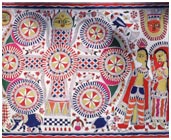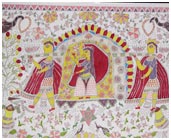Madhubani Painting is a famous genre of painting practiced in Bihar, India. It takes its name after the tiny hamlet of Madhubani.
Madhubani Painting
Madhubani can be referred to as a famous genre of Indian paintings, which takes its name from the tiny hamlet of 'Madhubani', in the Indian state of Bihar, where this art form originated centuries ago. The painting was, infact, pursued by the women folk of not just Madhubani, but also those in the adjoining regions of Mithila. As such, Madhubani painting is often referred to as Mithila painting also. The art form is known for the distinct style used therein, which is characterized by use of bright colors and vivid descriptions of the subjects. Apart from being popular in India, these paintings have managed to gather international acclaim as well. 

History
The exact reason or time of the origination of Madhubani or Mithila art is unknown. However, the legend has it that it came into vogue during the time of the Ramayana, when King Janak ordered the artists in his kingdom to make beautiful paintings for the wedding of his daughter, Sita, to Lord Rama. Initially, the women in Madhubani and Mithila started making the paintings on the walls of their huts. With time, the artists began creating Madhubani art on paper, cloth and canvas also. Though the domain of Madhubani has remained more or less confined, the art has been passed down from one generation to another continuously, with its basic content remaining the same.
Colors & Instruments
Madhubani can be described as a style of painting, rather than a set of pictures. It employs natural colors, with the most popular being deep red - derived from Kusuma flower. The other colors include green - from Bel trees, black - from burnt jowar, light yellow - from turmeric mixed with banyan leaf milk and orange - from Palasa flower. The colors, which are mostly bright, are used to impart two-dimensional imagery to the paintings. Madhubani painters use a very unusual form of brush for the art. Handmade, the brush is created out of a bamboo stick, with its end being slightly frayed.
Motifs
The subject of Madhubani paintings is mostly religious, including motifs of deities like Shiva, Vishnu, Krishna, Ram, Lakshmi, and Saraswati. Durga and Kali are also pre-dominant. The paintings also depict natural objects, like sun and moon, and religious plants, like tulsi (holy basil). Other motifs include scenes from the royal court and social events, like weddings, apart from activities from the daily life. In most of the cases, you will never find empty spaces in Madhubani paintings. More often than not, the gaps are filled with paintings of flowers, animals, birds, and even geometric designs.
Basic Characteristics
One of the basic characteristics of Madhubani paintings comprises of the vibrant and bold use of colors. Even traditional geometric patterns, which are related to, and support, the main theme is another typical aspect that one can find in the paintings. You will also come across distinctive styles, like double line border, elaborate floral patterns, abstract-like figures of deities and bulging eyes and a jolting nose (as a part of the face of the figures) in Madhubani paintings. In fact, all these aspects are what make this art form different from the others and impress the connoisseurs of art.


See also
More from iloveindia.com
- Home Remedies | Ayurveda | Vastu | Yoga | Feng Shui | Tattoos | Fitness | Garden | Nutrition | Parenting | Bikes | Cars | Baby Care | Indian Weddings | Festivals | Party ideas | Horoscope 2015 | Pets | Finance | Figures of Speech | Hotels in India : Delhi | Hyderabad | Chennai | Mumbai | Kolkata | Bangalore | Ahmedabad | Jaipur
- Contact Us Careers Disclaimer Privacy Policy Advertise With Us Lifestyle Sitemap Copyright iloveindia.com. All Rights Reserved.

